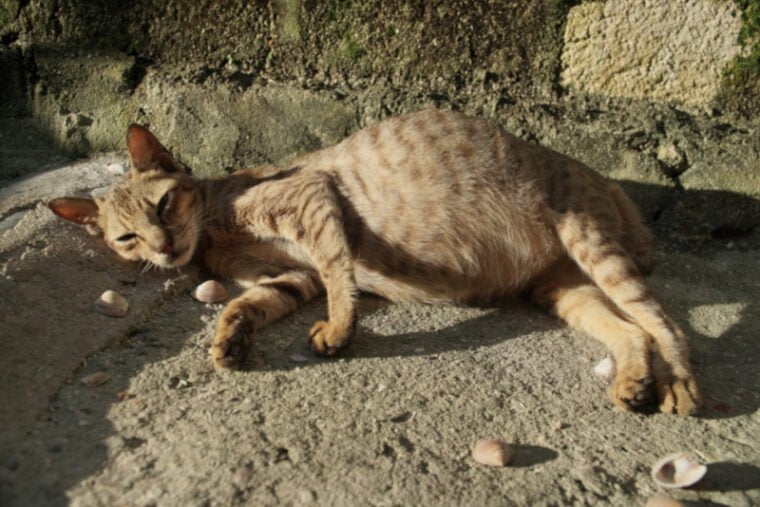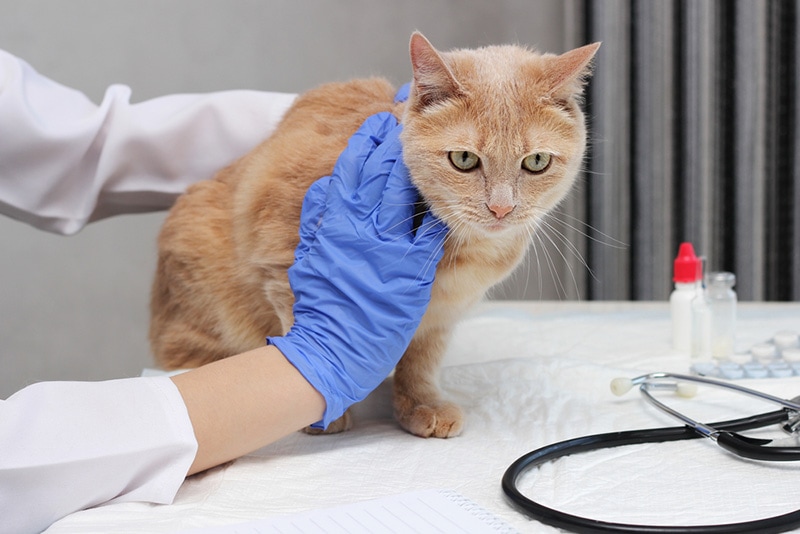
Click Below to Skip Ahead
Feline infectious peritonitis (FIP) is a severe viral disease that was considered fatal in almost 100% of cases, although in recent years, new developments in the treatment have occurred. This condition is extremely aggressive and has a fast process.
Affected cats have different clinical signs, depending on the body part affected and how their immune system reacts against the virus. Cats generally have a high fever, poor appetite, and lethargy. They can also develop diarrhea, distended abdomen, yellow mucous membranes, and may have difficulty breathing. FIP is found most frequently in households with several cats, in animals with a weakened immune system, and in very young or old cats.
It is difficult to diagnose and treatment remains complicated
What Is Feline Infectious Peritonitis?
FIP is a viral disease transmitted by a feline coronavirus (FCoV) from the family Coronaviridae. This virus has several strains, some pathogenic (i.e., that cause the disease) and others non-pathogenic (i.e., that cause no clinical signs).
Feline coronavirus is a single-stranded RNA virus (consisting of a single chain of polynucleotides) spread throughout the world. This virus is often found in the digestive tract of cats without causing disease. It is important to note that FCoV is not the same as SARS-CoV-2; the two viruses belong to different types.
The disease is more common in cat communities, where the virus spreads easily and quickly, generally infecting approximately 75% of the cat population. It is one of the most common diseases present in breeders, shelters, and adoption centers. It is important to note that it is estimated that only 5% of cats with FCoV infection develop FIP.
How Is Feline Infectious Peritonitis Transmitted?

Viral transmission occurs through feces, mostly indirectly through contaminated objects (such as litter boxes and cleaning items). The incubation period of this virus is variable and ranges from 2 weeks to a year. Once infected, cats can shed the virus for several days to several months. Around 13% of cats infected with FCoV remain asymptomatic carriers, i.e., they do not develop the disease, they only spread it.
In order for a cat to develop FIP, it must undergo certain mutations. There are also risk factors, such as the cat being young (under 2 years) or old (over 10 years of age).
What Are the Signs of Feline Infectious Peritonitis?
The clinical signs of FIP may vary depending on which strain of the virus is present, the state of your cat’s immune system, and the affected organs.
Both forms affect the whole body, from digestive signs to breathing difficulties.
What Are the Causes of Feline Infectious Peritonitis?
The main cause of the transition from a gastrointestinal syndrome (caused by FCoV) to a systemic disease with high mortality is the fact that the genome of the FCoV undergoes changes in its structure and switches from attacking the gastrointestinal cells to infecting the monocytes (white cell with a role in immunity). Although the reasons for these modifications are still unknown, it is assumed that stress and genetic factors play an important part.
Less than 10% of cats infected with FCoV develop FIP. Of this 10%, 70% are purebreds with pedigrees, and 50% are under 2 years of age. In other words, if your cat has FCoV, it does not mean they also have FIP.
How Is Feline Infectious Peritonitis Diagnosed?

This condition is difficult to diagnose because the clinical signs are easily confused with those of other conditions (especially in the dry form of the disease).
There are no laboratory tests for an exact diagnosis, and the veterinarian may recommend additional investigations for a presumptive diagnosis:
Rapid tests can diagnose the presence of FCoV in your cat’s blood, but this does not mean they have FIP. These tests simply indicate that your cat came into contact with the coronavirus at some point in their life.
How Is Feline Infectious Peritonitis Treated?
FIP has currently no specific treatment, and, unfortunately, euthanasia is sometimes recommended because the mortality rate is almost 100%.
Depending on the stage of the disease and its evolution, supportive treatments can be recommended. These can prevent secondary infections (which develop on a low immune status) through specific antibiotic therapy, maintain hydration through intravenous fluids, treat the inflammation, and support the immune system.
However, researchers have studied and developed a drug with a curative effect: the antiviral drug GS-441524. Although this drug is not yet approved on the pharmaceutical market and many of the side effects or long-term effects are unknown, studies show that it has promising results. This antiviral treatment is available in injectable and capsule forms. Based on a form that they sign, the owners acknowledge the related risks and the side effects that may occur.
How Do I Care for a Cat With Feline Infectious Peritonitis?

If your suffering cat has been diagnosed with FIP, you need to work closely with your vet to manage the disease. If the disease is severe, euthanasia will be recommended to end your pet’s suffering. If they have a milder form, what you can do is give them quality food, keep them warm and cozy, and eliminate the stress factors around them in order to offer them a peaceful life.
If your cat has been diagnosed with FCoV, you must isolate them from the group and keep them under observation. Stress (change of residence, transport, overcrowding, etc.), low immunity, state of maintenance (poor quality food, malnutrition, etc.), genetic receptivity, and other diseases have been proven to favor the mutation of this virus and implicitly, the development of FIP.
Frequently Asked Questions (FAQs)
How Long Do Cats Live With Feline Infectious Peritonitis?
FIP is considered fatal in almost 100% of cases. However, the survival time depends on the form that your cat has developed. If your cat has dry form, they may live for a few months. If your cat has been diagnosed with the wet form, they may live for a few weeks.
What Is Late-Stage FIP in Cats?
Cats with the late stage of FIP may exhibit wobbly walking, difficulty breathing, lethargy, and weight loss. In other words, your cat will struggle to breathe and will no longer be able to consume food. These clinical signs often require the consideration of euthanasia to end your cat’s suffering.
Conclusion
Feline infectious peritonitis, or FIP, is a viral disease produced by a mutation of the feline coronavirus, or FCoV. The disease has two forms, wet and dry, and the clinical signs will vary. There is still no safe, widely available, and effective treatment to treat FIP, and the disease is fatal in almost 100% of cases. Treatment is generally supportive, but cats may die in most cases within a few weeks (wet form) or months (dry form) after the diagnosis.
If your cat shows related clinical signs (anemia, diarrhea, lack of appetite, accumulation of fluid in the abdomen, or yellow mucous membranes and skin), lives with several cats in one place, and is very young or very old, you have to take them to the vet for an evaluation.
Featured Image Credit: sahlan, Shutterstock








